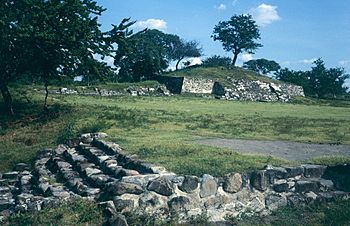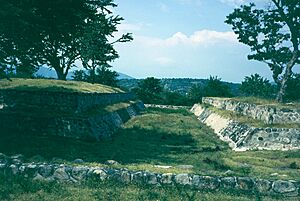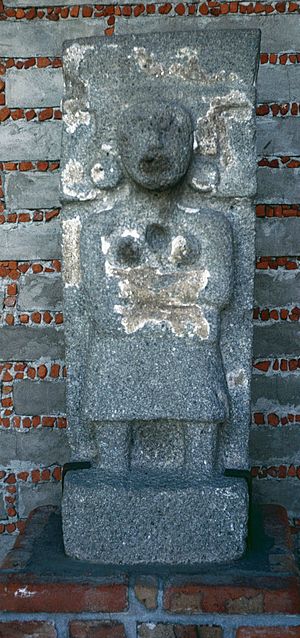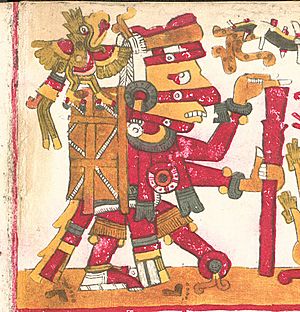Coatetelco archaeological site facts for kids

Main pyramid
|
|
| Location | Miacatlán, Morelos |
|---|---|
| Coordinates | 18°43′36″N 99°19′44″W / 18.72667°N 99.32889°W |
| History | |
| Periods | Late Preclassical Mesoamerican Period |
| Cultures | Tlahuica and Nahuatl |
Coatetelco (also spelled Cuatetelco) is an amazing ancient site in Mexico. It's located right next to the Coatetelco Lagoon. You can find it about two kilometers from Alpuyeca, in the Miacatlán area of Morelos. This historical place is also quite close to another famous site, Xochicalco. Coatetelco was a bustling city long ago, reaching its peak between 500 and 150 BCE.
Contents
What's in a Name?
The name Coatetelco has a few interesting meanings! Most people think it means "place of snakes' mounds." This suggests there might have been many snake-shaped hills or monuments.
However, other spellings give us different ideas:
- Cuatetelco could mean "mound place between trees" or "tree place on a mound." This comes from the Náhuatl language words for tree (cuahuitl) and mound (tetelli).
- Cuahtetelco might mean "place of the stone snake." This combines the Náhuatl words for snake (coatl) and stone (tetl).
- The Tlahuica language glyph for Quahtetelco shows a tree over a pyramid. This also points to a "place of trees on a mound."
A Look Back in Time
Long, long ago, at the end of the Ice Age, people lived in this region. They found shelter in rocky caves and survived by hunting, gathering plants, and fishing.
Later, during the Early Formative period, small villages started to appear. These villages had fewer than 100 people. They began farming near rivers and made their own pottery. They also created some of the first clay figures.
By the Mid-Preclassical period (900–500 BCE), more villages grew along the Chalma River. Farming became even more important. The pottery they made had its own special style, but it also looked a bit like pottery from other areas.
History of Coatetelco
Archaeologists have found proof that people lived at Coatetelco even during the time of the powerful Teotihuacan city (450-600 BCE). However, most of the buildings we see today are from a much later period, the Late Postclassical era (1350–1521). Many of these structures were built during the Mexica time. The buildings here were actually built in four different stages over many years.
Coatetelco was at its busiest and most important during the Late Preclassical period (500–150 BCE). During this time, the communities here had between 250 and 500 residents.
After the nearby city of Xochicalco became less important around 1000 CE, Miacatlán took over as the main center in the region. We know a lot about the history after this time from old written documents and special ancient books called codices.
Exploring the Ancient City
Coatetelco was a medium-sized ancient city. Archaeologists have dug up and restored the main part of the city. Here, you can see a special court for playing a ballgame, a small pyramid-temple, and other buildings. These structures are all grouped around a public square. There's also a small museum at the site where you can learn more.
Archaeologist Raúl Arana led the excavations at Coatetelco in the 1970s. He also oversaw the rebuilding of the ancient structures. Since then, smaller digs have happened to keep the site in good shape. The pottery found by Arana has been studied and described in a special book.
The buildings at Coatetelco include pyramid bases, platforms, and the ballgame court. They were built with an earth core and then covered with carved stones. Some parts still have walls and stairs with traces of the original stucco. All these buildings are arranged around a central square, following the natural shape of the land.
The Ballgame Court
The ballgame court is a very important part of Coatetelco. It's located behind the western platform. Finding a ballgame court here tells us that Coatetelco was a ceremonial center. The ancient ballgame was not just for fun; it also had religious and political meanings. This court is closed at one end and faces north-south. You can still see traces of the stucco that once covered it. Archaeologists also found remains of a tzompantli (a skull rack) near the court.
This ballgame court is quite small for the game. During excavations under the main stairway of the platform, archaeologists found special burials for important people. These burials included hundreds of offerings, like ceramic pots, shiny obsidian, beautiful jade, and copper-bronze items. They also discovered a group of basalt tools used for grinding corn on a metate. These tools were carefully placed beside the ballgame court and you can still see them today.
Important Platforms and Temples
Western Platform
The western platform is mostly destroyed now. It once had three structures with two stairways on the sides. At the top, there are still some remains of stucco floors and two stone "boxes." Next to this platform is a smaller one with two steps. Archaeologists found stone cylinder objects here, but no one knows exactly what they were used for.
Extension Platform
This platform is an extension of the ballgame court. It has a circular shape. It was probably built to honor Ehécatl, who was the ancient god of wind.
Eastern Platform
The eastern platform has several buildings that are connected. These might have been altars. Its importance as a ceremonial site was confirmed when many burial places were found here. Tombs and different kinds of offerings were discovered in the altar and on the stairs.
Incense Altar
This altar was named the incense altar because archaeologists found a stone sculpture of a female figure here. They also found some clay incense burners. These burners look like big ladles with long handles, similar to those shown in the ancient Mendocino Codex.
Xipe-Totec Platform
This platform is the last part of a connected basement. It's named the Xipe-Totec platform because a stone sculpture of the god Xipe-Totec was found here. This idea is also supported by a circular altar nearby and a special stone called a temalacatl. This stone was found in the ruins of a 16th-century chapel. In the Mexica religion, the temalacatl was a stone used for sacrifices and was connected to the god Xipe-Totec. The sculpture of Xipe-Totec was broken, missing its head and feet. It's thought that the Spanish, who often destroyed artifacts from the cultures they encountered, caused this damage.
Cuauhtlitzin Temple
The Cuauhtlitzin temple is known as the main temple because it's the tallest structure at the site. A wide set of stairs with side railings leads to the top. You can still see parts of the temple that once stood there. The pyramid-like bases of the temple are built on a slope and covered with stucco. At the bottom of the stairway, there's a badly damaged stone slab called a stele.
During the excavations, a stone sculpture of a female figure was discovered. This sculpture was identified as Cuauhtlitzin. It was a sculpted head hidden inside a carved stone vault.
Weather at Coatetelco
| Climate data for Coatetelco | |||||||||||||
|---|---|---|---|---|---|---|---|---|---|---|---|---|---|
| Month | Jan | Feb | Mar | Apr | May | Jun | Jul | Aug | Sep | Oct | Nov | Dec | Year |
| Mean daily maximum °C (°F) | 29.9 (85.8) |
32.6 (90.7) |
34.6 (94.3) |
36.6 (97.9) |
36.8 (98.2) |
33.3 (91.9) |
32.6 (90.7) |
32.5 (90.5) |
32 (90) |
32.0 (89.6) |
32.0 (89.6) |
30.8 (87.4) |
33.0 (91.4) |
| Mean daily minimum °C (°F) | 8.4 (47.1) |
9.8 (49.6) |
12.4 (54.3) |
15.5 (59.9) |
17.3 (63.1) |
17.4 (63.3) |
16.6 (61.9) |
16.4 (61.5) |
16.6 (61.9) |
14.2 (57.6) |
11.3 (52.3) |
9.2 (48.6) |
13.8 (56.8) |
| Average precipitation mm (inches) | 2.5 (0.1) |
0 (0) |
2.5 (0.1) |
5.1 (0.2) |
38 (1.5) |
180 (7.1) |
230 (9.2) |
160 (6.2) |
170 (6.6) |
69 (2.7) |
5.1 (0.2) |
0 (0) |
860 (33.9) |
| Source: Weatherbase | |||||||||||||
See Also
- Coatetelco, Morelos, the modern municipality




